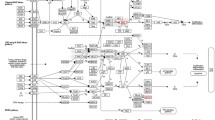Abstract
The present study was conducted to identify avian reovirus (ARV) proteins that can activate the phosphatidylinositol 3-kinase (PI3K)-dependent Akt pathway. Based on ARV protein amino acid sequence analysis, σA, σNS, μA, μB and μNS were identified as putative proteins capable of mediating PI3K/Akt pathway activation. The recombinant plasmids σA-pcAGEN, σNS-pcAGEN, μA-pcAGEN, μB-pcAGEN and μNS-pcAGEN were constructed and used to transfect Vero cells, and the expression levels of the corresponding genes were quantified by immunofluorescence and Western blot analysis. Phosphorylated Akt (P-Akt) levels in the transfected cells were measured by flow cytometry and Western blot analysis. The results showed that the σA, σNS, μA, μB and μNS genes were expressed in Vero cells. σA-expressing and σNS-expressing cells had higher P-Akt levels than negative control cells, pcAGEN-expressing cells and cells designed to express other proteins (i.e., μA, μB and μNS). Pre-treatment with the PI3K inhibitor LY294002 inhibited Akt phosphorylation in σA- and σNS-expressing cells. These results indicate that the σA and σNS proteins can activate the PI3K/Akt pathway.





Similar content being viewed by others
References
Vivanco I, Sawyers CL (2002) The phosphatidylinositol 3-kinase-AKT pathway in human cancer. Nat Rev Cancer 2:489–501. doi:10.1038/nrc839
Carpenter CL, Auger KR, Chanudhuri M, Yoakim M, Schaffhausen B, Shoelson S, Cantley LC (1993) Phosphoinositide 3-kinase is activated by phosphopeptides that bind to the SH2 domains of the 85-kDa subunit. J Biol Chem 268:9478–9483
Street A, Macdonald A, Crowder K, Harris M (2004) The hepatitis C virus NS5A protein activates a phosphoinositide 3-kinase-dependent survival signaling cascade. J Biol Chem 279:12232–12241. doi:10.1074/jbc.M312245200
Toker A, Cantley LC (1997) Signalling through the lipid products of phosphoinositide-3-OH kinase. Nature 387:673–676. doi:10.1038/42648
Alessi DR, Andjelkovic M, Caudwell B, Cron P, Morrice N, Cohen P, Hemmings BA (1996) Mechanism of activation of protein kinase B by insulin and IGF-1. EMBO J 15:6541–6551
Cantley LC (2002) The phosphoinositide 3-kinase pathway. Science 296:1655–1657. doi:10.1126/science.296.5573.1655
Datta SR, Brunet A, Greenberg ME (1999) Cellular survival: a play in three Akts. Genes Dev 13:2905–2927. doi:10.1101/gad.13.22.2905
Labrada L, Bodelón G, Viñuela J, Benavente J (2002) Avian reoviruses cause apoptosis in cultured cells: viral uncoating, but not viral gene expression, is required for apoptosis induction. J Virol 76:7932–7941. doi:10.1128/JVI.76.16.7932-7941.2002
Shih WL, Hsu HW, Liao MH, Lee LH, Liu HJ (2004) Avian reovirus sigmaC protein induces apoptosis in cultured cells. Virology 321:65–74. doi:10.1016/j.virol.2003.12.004
Lin PY, Liu HJ, Liao MH, Chang CD, Chang CI, Cheng HL, Lee JW, Shih WL (2010) Activation of PI 3-kinase/Akt/NF-kappaB and Stat3 signaling by avian reovirus S1133 in the early stages of infection results in an inflammatory response and delayed apoptosis. Virology 400:104–114. doi:10.1016/j.virol.2010.01.024
Liu HJ, Lee LH, Hsu HW, Kuo LC, Liao MH (2003) Molecular evolution of avian reovirus: evidence for genetic diversity and reassortment of the S-class genome segments and multiple cocirculating lineages. Virology 314:336–349. doi:10.1016/S0042-6822(03)00415-X
Teng L, Xie Z, Xie L, Liu J, Pang Y, Deng X, Xie Z, Fan Q, Luo S, Feng J, Khan MI (2014) Sequencing and phylogenetic analysis of an avian reovirus genome. Virus Genes 48:381–386. doi:10.1007/s11262-013-1029-5
Kay BK, Williamson MP, Sudol M (2000) The importance of being proline: the interaction of proline-rich motifs in signaling proteins with their cognate domains. FASEB J 14:231–241
Pawson T (1995) Protein modules and signalling networks. Nature 373:573–580. doi:10.1038/373573a0
Shin Y-K, Liu Q, Tikoo SK, Babiuk LA, Zhou Y (2007) Influenza A virus NS1 protein activates the phosphatidylinositol 3-kinase (PI3K)/Akt pathway by direct interaction with the p85 subunit of PI3K. J Gen Virol 88:13–18. doi:10.1099/vir.0.82419-0
Songyang Z, Shoelson SE, Chaudhuri M, Gish G, Pawson T, Haser WG, King F, Roberts T, Ratnofsky S, Lechleider RJ et al (1993) SH2 domains recognize specific phosphopeptide sequences. Cell 72:767–778. doi:10.1016/0092-8674(93)90404-E
Zhang B, Spandau DF, Roman A (2002) E5 protein of human papillomavirus type 16 protects human foreskin keratinocytes from UV B-irradiation-induced apoptosis. J Virol 76:220–231. doi:10.1128/JVI.76.1.220-231.2002
Xie Z, Qin C, Xie L, Liu J, Pang Y, Deng X, Xie Z, Khan MI (2010) Recombinant protein-based ELISA for detection and differentiation of antibodies against avian reovirus in vaccinated and non-vaccinated chickens. J Virol Methods 165:108–111. doi:10.1016/j.jviromet.2009.12.008
Wang X, Zhang H, Abel AM, Young AJ, Xie L, Xie Z (2014) Role of phosphatidylinositol 3-kinase (PI3K) and Akt1 kinase in porcine reproductive and respiratory syndrome virus (PRRSV) replication. Arch Virol 159:2091–2096. doi:10.1007/s00705-014-2016-4
Ehrhardt C, Marjuki H, Wolff T, Nürnberg B, Planz O, Pleschka S, Ludwig S (2006) Bivalent role of the phosphatidylinositol-3-kinase (PI3K) during influenza virus infection and host cell defence. Cell Microbiol 8:1336–1348. doi:10.1111/j.1462-5822.2006.00713.x
Sarkar SN, Peters KL, Elco CP, Sakamoto S, Pal S, Sen GC (2004) Novel roles of TLR3 tyrosine phosphorylation and PI3 kinase in double-stranded RNA signaling. Nat Struct Mol Biol 11:1060–1067. doi:10.1038/nsmb847
Giorgione JR, Huang Z, Epand RM (1998) Increased activation of protein kinase C with cubic phase lipid compared with liposomes. Biochemistry 37:2384–2392. doi:10.1021/bi970873e
Pramfalk C, Lanner J, Andersson M, Danielsson E, Kaiser C, Renström I-M, Warolén M, James SR (2004) Insulin receptor activation and down-regulation by cationic lipid transfection reagents. BMC Cell Biol 5:1–7. doi:10.1186/1471-2121-5-7
Acknowledgments
We thank Dr. Xiuqing Wang (South Dakota State University) for providing the pcAGEN vector.
Author information
Authors and Affiliations
Corresponding author
Ethics declarations
Funding
This study was founded by National Natural Science Foundation of China (no. 31160512), Guangxi Science and Technology Bureau (no. 2013GXNSFBA019120) and Guangxi Government Senior Scientist Foundation (no. 2011B020).
Conflicts of interest
The authors have no conflicts of interest to declare.
Ethical approval
This article does not contain any studies with human participants or animals performed by any of the authors.
Rights and permissions
About this article
Cite this article
Xie, L., Xie, Z., Huang, L. et al. Avian reovirus σA and σNS proteins activate the phosphatidylinositol 3-kinase-dependent Akt signalling pathway. Arch Virol 161, 2243–2248 (2016). https://doi.org/10.1007/s00705-016-2908-6
Received:
Accepted:
Published:
Issue Date:
DOI: https://doi.org/10.1007/s00705-016-2908-6




